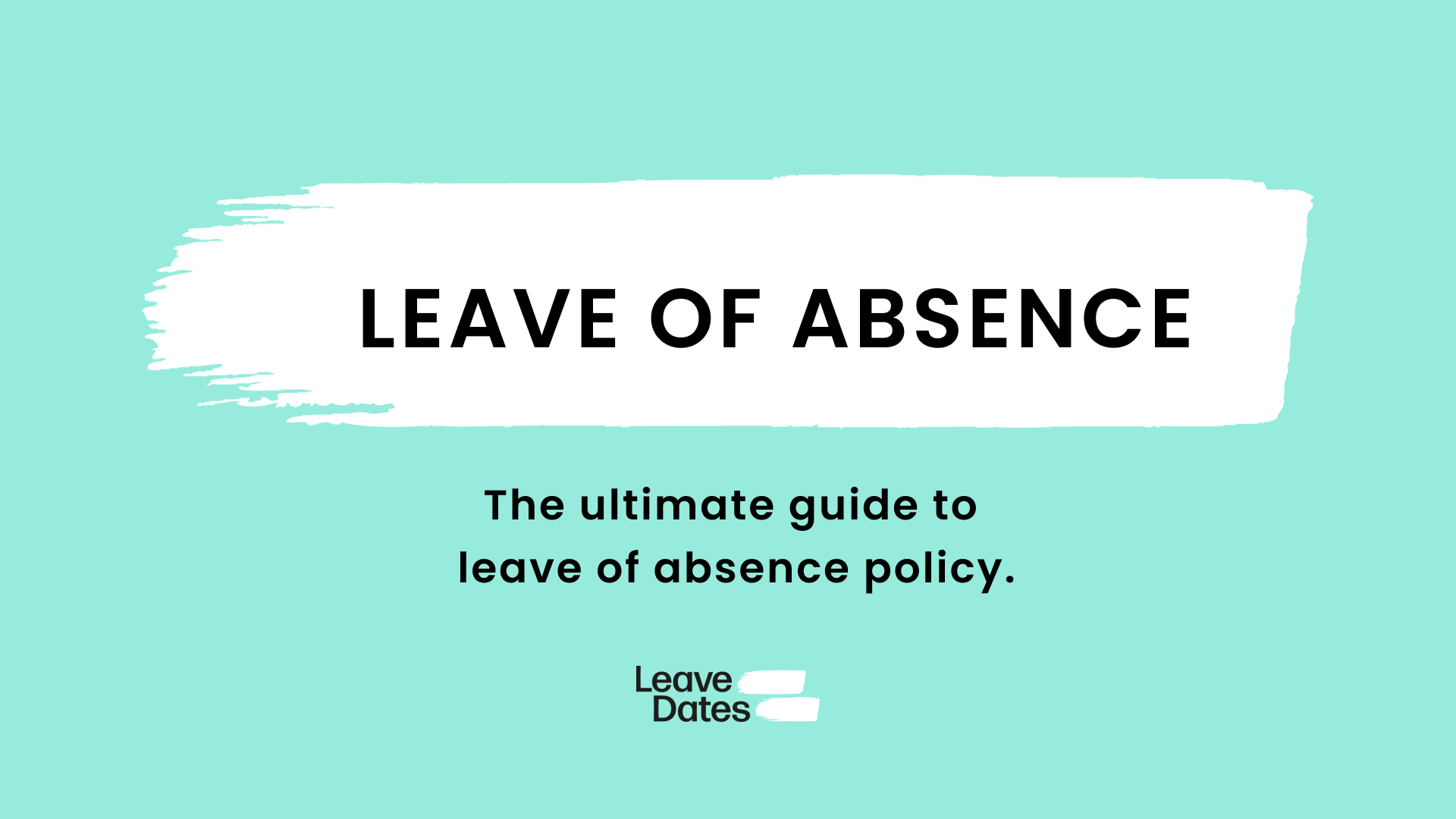
In our increasingly fast-paced world, unforeseen and/or extraordinary circumstances can arise that disrupt the usual flow of life and work. These can be good things (a baby, yay!), upsetting things (a bereavement, a difficult diagnosis), or just ‘life’ things (education, travel, service of some kind). In all cases, they involve a particular personal challenge that can sometimes create the need for a medium to long-term leave of absence from work whilst it is dealt with.
This article will talk about how to support your team, create a compassionate culture and navigate leaves of absence with empathy while protecting business viability and continuity.
Table of contents
- What is a leave of absence
- Why would an employer grant a Leave of Absence?
- Potential organisational impact
- Challenges of reintegration
- Combating stigma
- In summary
What is a leave of absence?
A leave of absence (LoA) is different from your typical time off – annual leave, general sick leave etc – in that it’s an extended ‘break’ from your job, without losing the status of employee. So you still work there, you’re just not working at the moment. It’s not a paid holiday; you’re taking some time out.
In general, this situation occurs because there is a specific, time-sensitive reason you cannot perform your professional duties. Some of these reasons, such as having a baby, are governed by law, but all circumstances will require unique consideration and employers must be able to adapt their approach to best support the diverse needs and situations of their staff.
Reasons for a LoA might include:
- Parental leave – typically the most common reason for an LoA, taken to care for and bond with a newborn/newly adopted child and adapt to life as a working parent.
- Other caring responsibilities – there may be situations when an elderly family member, sick child, or disabled partner requires dedicated time and attention
- Personal health issues – for example a serious illness, physical or mental, especially one requiring extended treatment, where the added stress of work responsibilities may hinder or prolong recovery
- Pursuit of further education or professional development – some employees might require or request extended time away from work to enhance their skills and/or knowledge
- Military duties – various countries, including Switzerland, Singapore and multiple Nordic nations, have mandatory or selective compulsory military service, and any employees serving in armed forces may require leave if they are deployed or for training purposes
- Jury duty – an employee might be called to serve on a jury, with timelines often unclear or subject to change
- Unforeseen emergencies – this could be anything from an accident, natural disaster or other extraordinary circumstance that necessitates immediate leave to address something unavoidable and urgent
- Mandatory LoA – in certain situations, employers may enforce mandatory leave for one, some or all employees via a furlough arrangement, for example if an employee is being investigated, the company is in financial difficulty or has to pause operations, or there’s a global pandemic…
Why would an employer grant a Leave of Absence?
There are multiple reasons to grant employees an LoA. In some cases, such as parental leave, it’s because they must. Adherence to the relevant labour laws is of course essential to avoid disputes and legal issues. But it’s about more than compliance – a company’s willingness to grant LoAs is an act of empathy and understanding, a recognition of the humanity of employees (and employers).
By allowing people to take extended time off in a time of great need, and often intense emotion and/or stress, a company can foster loyalty and commitment. It signals to employees that they are valued as people, beyond their professional and labour contributions, that their wellbeing is a priority. When they feel cared for and supported, they are more likely to reciprocate with increased dedication and loyalty.
Furthermore, it contributes to a genuinely family-friendly culture that recognises the importance of work-life balance, rather than paying the idea lip service while putting up barriers for employees with family responsibilities through restrictive, inflexible or hard to access leave-requesting processes.
This can go a long way towards preventing burnout and potentially the loss of valuable employees, and contributes to a positive, healthy workplace in which people (and the business) are able to thrive.
It also strengthens the relationship between employer and employee, through feelings of trust and mutual respect, resulting in stronger morale, increased job satisfaction and better team dynamics – and less absenteeism.
Addressing any health or personal concerns quickly by granting LoAs where they are needed allows employees to take necessary action and return to work with renewed energy and focus when they are able. Mentally and physically well employees are more engaged, efficient and productive .
It also creates an environment in which innovation and creativity can thrive – when employees feel safe, valued and supported, they are more confident, making them much more likely to suggest new ideas and solutions.
A compassionate approach to LoA demonstrates that a company genuinely lives its values, which can enhance its reputation (and brand image, where relevant) and generate loyalty among both employees and customers/clients. It also makes it an attractive employer for top talent, which helps hugely with recruitment and retention, with associated cost savings.
Some absences have more direct business benefits. Employers that allow or encourage educational LoAs not only demonstrate that they value their employees’ growth and are willing to invest in their future (again making for an extremely attractive employer), but they also stand to benefit from the application of the knowledge and skills gained by that individual once they return to work.
Potential Organisational impact
While it’s essential from an employee welfare point of view to grant an LoA, clearly there is scope for this to be detrimental from a business perspective, not least by increasing workloads for remaining employees.
This should not, and needn’t be, a barrier to allowing LoAs, as the negative impact can be mitigated through proper planning and communication to ensure smooth transitions when leaving and returning to work so that disruption is minimised.
An online leave planner is a great way of visualising available resources and ensuring there is visibility around any extended leave so that no one is kept in the dark, and other types of leave for remaining employees can be planned in the most efficient way.
This will highlight any resource gaps and enable management to take necessary decisions on any temporary hires or redistribution of workload.
As with managing other types of leave, communication is essential.
Depending on the nature of the leave and the wishes of the leave taker, open discussion of what needs to happen and why can foster a sense of solidarity among the relevant team and motivate them to collaborate and work together to find solutions to manage the workload.
This should avoid any resentment or misunderstanding of the situation, and acknowledging the extra effort put in by others will help to maintain morale.
Challenges of reintegration
LoAs are intended to end with the employee returning to work in the same role.
Successful reintegration into that role, especially if it has been performed by someone else in their absence, requires sensitivity and support.
The individual concerned may experience feelings of anxiety and/or inadequacy upon returning to work, and employers must be proactive in anticipating and addressing such challenges to facilitate a smooth transition.
Again, communication is key.
Conversations should be had with the employee prior to their return so that they can raise any concerns ahead of time, discuss any changes that have occurred in their absence and outline clear expectations on both sides.
Depending on the reason for the LoA, it may not be possible or helpful for the person to return immediately full-time; a gradual or flexible return schedule where responsibilities increase over time may be preferable for all.
Depending on the length of absence, it may be that additional training is required if the role has evolved or the employee needs to update their skills. A mentor or ‘buddy’ could provide an additional support system to help the returning employee navigate their reintegration, particularly if there have been a lot of changes within the organisation or team.
Above all, it’s important that the employer and/or manager concerned acknowledges the employee’s contributions and importance and reaffirms the organisation’s commitment to reintegrating them successfully.
Recognising the resilience and dedication they have shown in first taking the time they needed to address a challenge or fulfil an obligation, and then in returning to work after an extended absence, can go a long way towards building their confidence and increasing motivation to succeed.

Combating stigma
Taking the time to prioritise and support successful reintegration is especially important in cultures and societies where there might be a social stigma associated with taking an LoA.
In these situations, employees might fear judgement from their colleagues or missing out on career opportunities due to being perceived as lacking in commitment or capability.
Creating and then promoting policies and a workplace culture that supports work–life balance and values employee wellbeing will contribute hugely to reducing any such stigma.
Open conversations (and access to resources) about mental health, caregiving responsibilities and just generally ‘the juggle’ of modern life help to build a culture of understanding and appreciation for others and of the richness and complexity of their individual lives, of which work is just one part.
In summary…
Navigating leave of absence, one of the most wide-ranging and potentially sensitive types of leave, doesn’t have to be complex.
Whatever the situation, the key is always empathy. Empathy for one’s employees and colleagues is the start of a virtuous cycle of benefits for your people that drive benefits for your business.
If you keep your focus on supporting your people, taking time to understand the different reasons for LoAs and providing the necessary support to enable staff to take (and return from) extended absence, your business’s viability won’t be compromised – indeed, you are far more likely to see it thrive.
There are plenty of tools and strategies to ensure business continuity in all manner of circumstances, but an inclusive and compassionate work culture is built over the long-term. Business success cannot be separated from employee wellbeing – a modern, ethical employer knows this and has it built into their policies and processes and the very fabric of their organisation.
Investing in employee welfare through a permissive and empathetic approach to granting leaves of absence is not only the right thing to do for your people, but also a strategic decision that will deliver consistent returns throughout every level of your organisation.



